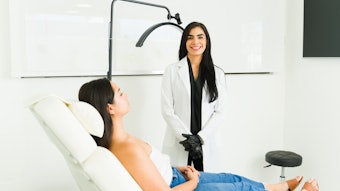
Spa professionals need to make sure to point out any concerning moles or lesions to clients and work with them to ensure that they see a dermatologist as soon as possible when a spot is found. You could be saving the life of a client.
Now there are twice as many reasons people should visit a dermatologist for yearly skin cancer exams. According to a recent study in the Journal of the National Cancer Institute, people with a history of nonmelanoma lesions face twice the risk of developing other cancers.
Those systemic malignancies include melanoma, lung, colon and breast cancers. Patients who develop skin cancers may have inherited a family tendency for other types because of an inadequate ability to repair DNA. In addition, the younger a person gets a nonmelanoma skin cancer, the higher her risk of developing other cancers.
More than one million new cases of skin cancer are diagnosed in the United States each year, outnumbering all other cancers combined. One in five Americans will develop the disease at some point, yet it is one of the most preventable types of cancer.
According to dermatopathologist George Hollenberg, MD, medical director of Acupath Laboratories in Long Island, New York, "There is no reason to delay a clinical exam for skin cancer. The risk is just too big."
The prevalence of skin cancer screening among adults inched higher during the first half of this decade, according to the Centers for Disease Control and Prevention. In 2000, one in seven adults said they had ever undergone a head-to-toe skin exam by a dermatologist or other physician; by 2005, this figure rose to one in six. Those are still risky odds. An annual screening is ideal because finding a growth in its early stages can mean the difference between life and death.
"Most melanomas can be seen by the naked eye," adds Hollenberg. "Usually there is a long period of time when the tumor grows beneath the top layer of skin but does not penetrate the deeper layers. This slow growth means the cancer may be cured if a tumor is found before it spreads deeper." Mortality rates are directly related to the depth of the cancer. If all skin cancers were found and treated early on, the disease would be nearly 100% curable.
Researchers speculate that the popularity of tanning beds may be one cause of higher melanoma rates. Exposure to UV radiation from indoor tanning lamps has been linked to both melanoma and squamous cell cancer. For young women, using tanning beds for the first time before age 35 increases melanoma risk by as much as 75%. In response to skin cancer concerns, some states now require parental consent for teenagers or ban anyone under 18 from using salon tanning beds.
Hollenberg clarifies the process and importance of vigilant screening:
How often should someone check for abnormalities? Do monthly self-exams for suspicious moles and spots. Recruit a partner for those hard-to-spot spots. If you notice anything changing, growing or bleeding on your skin, see a dermatologist.
Who is at risk? It's misleading to think that only a certain demographic should be screened. Exams are a necessary routine no matter your age or your ethnicity. According to Hollenberg, it's a myth that melanoma primarily affects older people: It is the No. 1 cancer in adults aged 25–29.
Do I need a doctor's opinion? A dermatologist or regular provider should perform a clinical skin exam at least once a year (more often if you have a history of skin cancer). Through the American Academy of Dermatology's National Melanoma/Skin Cancer Screening program, volunteer doctors perform free skin cancer screenings.
Multiple studies have shown that physicians are more likely to detect melanomas at a thinner stage compared with nonphysicians. According to recent research, 81% percent of physician-detected melanomas were clinically thin compared with 62% percent of melanomas detected by laypersons. Research published in the August 2009 issue of Archives of Dermatology showed that most melanomas detected in a dermatology office were found as a result of doctor-initiated exams instead of a specific patient complaint. Doctors can educate patients about the signs and symptoms of melanoma and train them in how to perform a thorough self-examination with the aid of informational brochures, handheld mirrors, combs and hair dryers.
What to look for? The American Academy of Dermatology has revised the "ABCDs of Melanoma Detection" by adding an "E" for evolving. A mole or skin lesion that is evolving, or changing in size, shape or color should be brought to the attention of a dermatologist. This is in addition to other characteristics of moles for which individuals should check their skin: Asymmetry (one half unlike the other half), Border (irregular, scalloped or poorly defined), Color (varies from one area to another; shades of tan and brown, black; sometimes white, red or blue), and Diameter (the size of a pencil eraser or larger). A mole with any of these characteristics, or one that is an "ugly duckling", meaning it looks different from the rest, should be brought to a dermatologist's attention.
What happens next? If an area on the skin looks abnormal, a doctor may recommend a biopsy."A biopsy is the only certain way of identifying skin cancer and determining the specific type of cancer," says Hollenberg. In a biopsy, the doctor removes suspicious cells or tissues with a local excision. A dermatopathologist then examines the growth under a microscope to check if it is benign or malignant.










